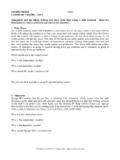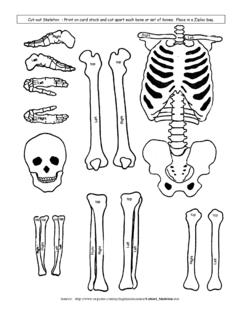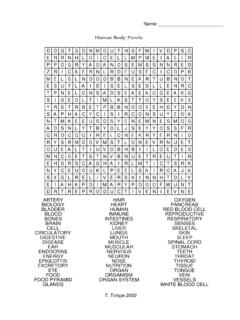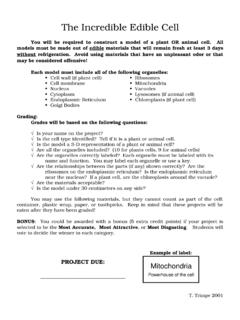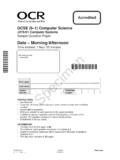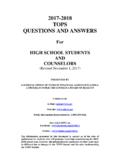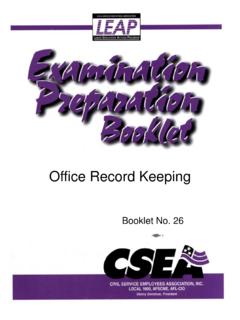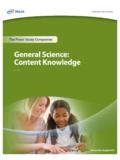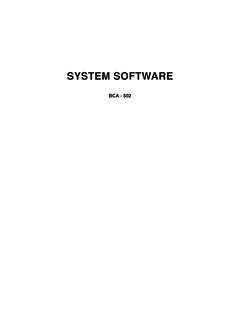Transcription of Teacher Notes - sciencespot.net
1 Tracy Trimpe 2006 Teacher Notes Purpose: As a result of this lesson, students will become familiar with common organisms found in a pond and discover their importance in a balanced aquatic habitat. At the end of the lesson, students will create food webs to illustrate the relationships between organisms that live in or near a pond. They will also create trading cards that will allow them to learn more about the aquatic organisms and can be used as identification guides for field trips to local ponds, lakes, or rivers. Lesson Objectives As a result of this lesson, students will be able to: (1) Identify common microorganisms and macroorganisms living in an aquatic environment. (2) Describe the various organisms found in freshwater habitats based on classification, movement, reproduction, diet, etc.
2 (3) Create a food web illustrating the relationship of organisms in an aquatic habitat. (4) Determine water quality by evaluating the presence of specific species of organisms. Materials Water samples from a local pond (or access to a pond during a field trip) Hand lenses Microscopes, slides, cover slips, and eyedroppers Small containers for water samples Identification guides or access to websites with identification keys Small Post-It Notes (or other small pieces of paper) Large sheets of construction paper Index Cards Copies of student worksheets Computer microscope or camera (optional) Lesson Procedures Part A: Introduction 1. Divide students into teams consisting of 3 - 4 students. Ask each group to brainstorm a list of plants and animals that live in or near a pond.
3 Use the group responses to create a class list. 2. Ask students to list at least three questions they have about ponds. Review the students questions to assure that activities and resources that will be provided during the unit to allow them to discover the answers to their questions. Part B: Take a Closer Look 1. If students are not familiar with the use of microscopes or have not made wet-mount slides, provide instruction in these areas to prepare the students for this portion of the lesson. 2. Allow students to collect water samples from the schoolyard pond or bring in samples from other ponds in the community. Allow time for students to make observations of the pond water samples and identify any macroorganisms they find. Identification guides, websites, or other resources that are available will allow them to learn more about each organism.
4 Provide microscopes to allow students to take a closer look at the macroorganisms. Provide copies of the lab worksheet to allow students to document their observations. Tracy Trimpe 2006 3. Provide time for students to prepare wet-mount slides and use microscopes to survey the water samples for microorganisms. Identification guides, websites, or other resources that are available will allow them to learn more about each organism. Remind students to document their observations on the lab worksheet. NOTE: If you have access to a computer microscope or camera, allow students to capture images of the organisms and incorporate those into the trading cards created later in the lesson. The cards can be used to create identification guides for use during field trips to local ponds, lakes, or rivers.
5 Part C: Making a Connection 1. Ask students to review the class list of plants and animals from the lesson introduction. Ask them if they would like to add anything to the lists. Allow time for the groups to update the lists based on their observations of the pond water samples. 2. Provide small Post-It Notes (or other small pieces of paper) for each group and instruct students to write the names of at least 10 of the plants and animals on the class list. 3. Challenge the students to create a food web using the Post-It Notes . Provide a large piece of construction paper to create a display. Access to websites and other reference materials will allow students to learn more about the animals diets. 4. Allow time for the groups to compare their food webs.
6 Challenge students to predict what would happen if (1) a specific organism was removed from the web due to disease or pollution, (2) the population of one organism was to double, or (3) an exotic (invasive) species was introduced to the food web. Part D: Trading Cards 1. Create a class list of organisms the students observed in the pond water samples. 2. Provide the trading card template and index cards. Allow time for each student to create a card featuring one of the organisms from the class list. Provide access to websites or printed resources to allow students to research the organisms and find the information they need to complete the trading cards. 3. Provide copies of an identification guide that classifies organisms based on their level of tolerance for pollution.
7 Discuss how scientists use their observations of macroorganisms to determine the water quality for a pond or other body of water. 4. Allow time for the students to compare their trading cards and participate in classification activities using their trading cards. For example, you can have the students find other students with cards that have the same classification (insect, spider, etc.), type of movements, diets, life cycles, or levels of tolerance. Discussion Questions 1. What is the difference between microorganisms and macroorganisms? 2. What is the difference between phytoplankton and zooplankton? 3. Which organisms were most abundant? 4. How could we determine population counts of an organism? 5. How would your food web change if one of the organisms was to be removed from the web due to a disease or pollution?
8 6. What can we learn about the quality of water in an aquatic habitat based on the organisms we observe? 7. What can we do to protect the freshwater habitats in our area? Tracy Trimpe 2006 Assessment Students will be assessed through a variety of methods throughout the project. During the introduction, student responses will be evaluated to gain insight into their knowledge of the various life forms found in an aquatic habitat. Student groups will be observed as they create wet-mount slides and use the microscopes to identify organisms. The Teacher will evaluate the proper use of the microscopes and identify those students that need additional guidance. The food webs will be evaluated to determine if the students were able to organize the plants and animals to create an accurate food web.
9 Evaluating student responses during follow-up discussions will allow the Teacher to identify misconceptions and provide additional activities to address them. The trading cards will be graded based on accuracy of the diagram, required information, and overall effort. Extension Ideas 1. Invite a local biologist to visit the class and assist students in identifying the organisms that were found. Allow time for the students to ask any questions they may have. 2. Provide water testing equipment and allow time for students to collect data. Discuss methods they might incorporate to ensure accurate and reliable results. Allow time for students to compare their test results to their predictions of water quality based on the presence of specific species of organisms.
10 3. Take a field trip to a pond or lake in your community. Allow time for students to reinforce their classroom learning by collecting samples and identifying the organisms they find. Take the water samples back to the classroom and use microscopes to find other organisms. Ask students to compare the samples from the field trip to those from the schoolyard pond. If you are not able to take a field trip, ask students to bring in water samples from other ponds in the community. 4. Challenge students to devise methods for determining population counts for various organisms found in the pond water samples to determine which organisms were most abundant. Use the data to create graphs or charts to compare the population of several of the species.


